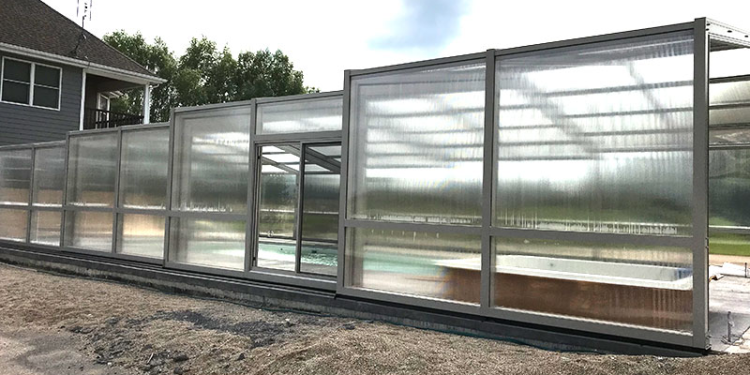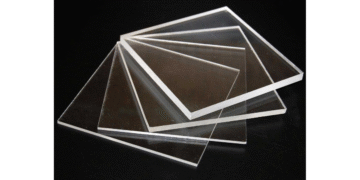Winter comes again and swimming pool domes are a must to protect your pool from dirt and damage you know that can use them all winter long and with less maintenance which helps us continue to enjoy it. Select pool dome cover for winter Glass and polycarbonate are two of the most used materials for pool dome covers.
Each offers its pros and cons, so pool owners need to understand the big differences before deciding. In this article, compare glass vs polycarbonate pool dome covers on durability, insulation, safety, maintenance, cost, aesthetics, and installation.
Choose Right Pool Dome Cover Glass VS Polycarbonate
The ideal swimming pool dome cover will vary depending on durability, insulation, price, and appearance. Glass is a heavier material and gives a high-end look, but it is expensive. Polycarbonate, a strong but lightweight type of plastic, has better-insulating properties and is more cost-effective in extreme weather than glass.
- Durability and Strength
One of the primary considerations when selecting a pool dome cover for winter is durability. Heavy snow, high winds, and cold temperatures all have a victory over poorly built domes, so you should construct strong and durable ones.
- Glass: Glass pool domes are extremely strong and will last, particularly if they‘re made from tempered or laminated glass. Tempered glass is four times stronger than normal glass and is resistant to moderate impacts. Glass can shatter with too much force in extreme conditions, and fixing or replacing it isn’t cheap.
- Polycarbonate: Another extremely tough material, polycarbonate is one of the highest-rated non-glass materials rated about 200 times stronger than glass. This makes it nearly impossible to break which is why it is commonly used on winter pool enclosures that are open to foul weather. Polycarbonate will not crack under hail, heavy snow, and high winds and, for this reason, is the more resilient choice for extreme climates.
- Energy Efficiency and Insulation
Heating the pool in winter is essential to ensure low energy costs and comfortable swimming conditions.
- Glass: Polycarbonate allows for better heat retention and insulation compared to glass. Specialized coatings like Low-E (low emissivity) glass can be applied to boost thermal efficiency, but glass tends to let more heat out compared to other materials, driving up heating costs.
- Polycarbonate: Some models provide up to 60% better insulation than glass, polycarbonate is the perfect insulator. The outer wall of the dome is made of multi-wall polycarbonate sheets that trap air between their multiple layers, minimizing heat loss and maintaining a steady temperature within the dome. Polycarbonate therefore has the advantage for energy savings in winter.
- Safety and Impact Resistance
Pool domes should be safe according to the location specifically in storm-prone areas and with falling debris or high-impact accidents.
- Glass: Even tempered or laminated glass is much stronger than standard glass, but can still shatter with hard impact. If broken, tempered glass breaks into tiny, less harm-causing pieces, while laminated glass sticks together and reduces injury likelihood. Repairs and replacements, however, are usually expensive.
- Polycarbonate: Polycarbonate is nearly unbreakable and is far more impact-resistant than glass. It does not break, making it a better choice for families with children, and for areas prone to hail, after a rain storm with falling branches, or accidents.
- Maintenance and Cleaning
To maintain both visibility and longevity, pool domes need to be cleaned and maintained regularly.
- Glass: This material is less likely to scratch. However, it also needs routine cleaning to remove dirt, water stains, and algae that build up over time in hot and humid pool environments. To keep it looking pristine, special cleaning agents might be required.
- Polycarbonate: Easy to clean but prone to scratching more than glass. {“I”} Anti-scratch coatings may assist, but without utilizing proper care, the surface can acquire superficial abrasions over time. It doesn’t need as frequent maintenance as glass.
- Cost Considerations
Cost is a major consideration, especially when you are deciding between a glass and polycarbonate pool dome cover.
- Glass: Glass pool domes are generally the most expensive type — they are costlier than polycarbonate domes, including materials and installation. Furthermore, custom glass (such as Low-E or laminated) escalates costs even further.
- Polycarbonate: Compared to glass, it is much cheaper and cost-effective for pool owners. Its lighter weight also leads to lower installation costs, making it a more cost-effective solution for large or custom-shaped enclosures.
- Aesthetic and Visibility
A dome over your pool should not just be functional, it should improve the overall aesthetics of your pool area.
- Glass: A sleek sophisticated look with a clear view. It allows an uninterrupted line of sight to the environment, making it a standard for high-end swimming pool enclosures.
- Polycarbonate: This material also comes in clear, tinted, or frosted styles for some design versatility. However, because it does not offer the same clarity as glass, some distortion may be present, a potential negative for those who want a high-quality appearance.
- Installation and Weight
Installation is another major factor influencing the viability of a pool dome cover.
- Glass: Heavier than polycarbonate and thus a more difficult and time-consuming installation. It typically needs a reinforced frame and expert care, all driving up labor costs.
- Polycarbonate: The lightweight, easy-to-install polycarbonate is a good option if you need to do some DIY work or have it done quickly by a pro. Its flexibility supports increased design versatility, including curved or retractable enclosures.
Which One Should You Choose?
- Choose Glass Pool Dome Covers If You:
- An emphasis on aesthetics and a high-end, luxurious appearance
- Looking for a durable and scratch proof material.
- Live in a temperate climate with low chances of climate disasters.
- Are prepared to pay a higher initial cost for a high-quality enclosure.
- Choose Polycarbonate Pool Dome Covers If You:
- need a tough and resistant cover to endure the rough weather.
- More insulation to save on heating bills.
- Want something lightweight and easy to install?
- Instead, you want a more affordable, energy-efficient, easy-to-use solution.
Conclusion
Glass pool dome covers and polycarbonate pool dome covers each have their pros and cons. Glass is king in terms of aesthetics and scratch resistance, and those looking for luxury may be tempted by this.
While glass provides a sufficient visible barrier, polycarbonate excels in durability, insulation, impact resistance, and cost-effectiveness, making it the perfect option for winter protection. When weighing the decision to go with one over the other take into account your budget, climate, aesthetics, and maintenance needs for the best pool cover choice.













